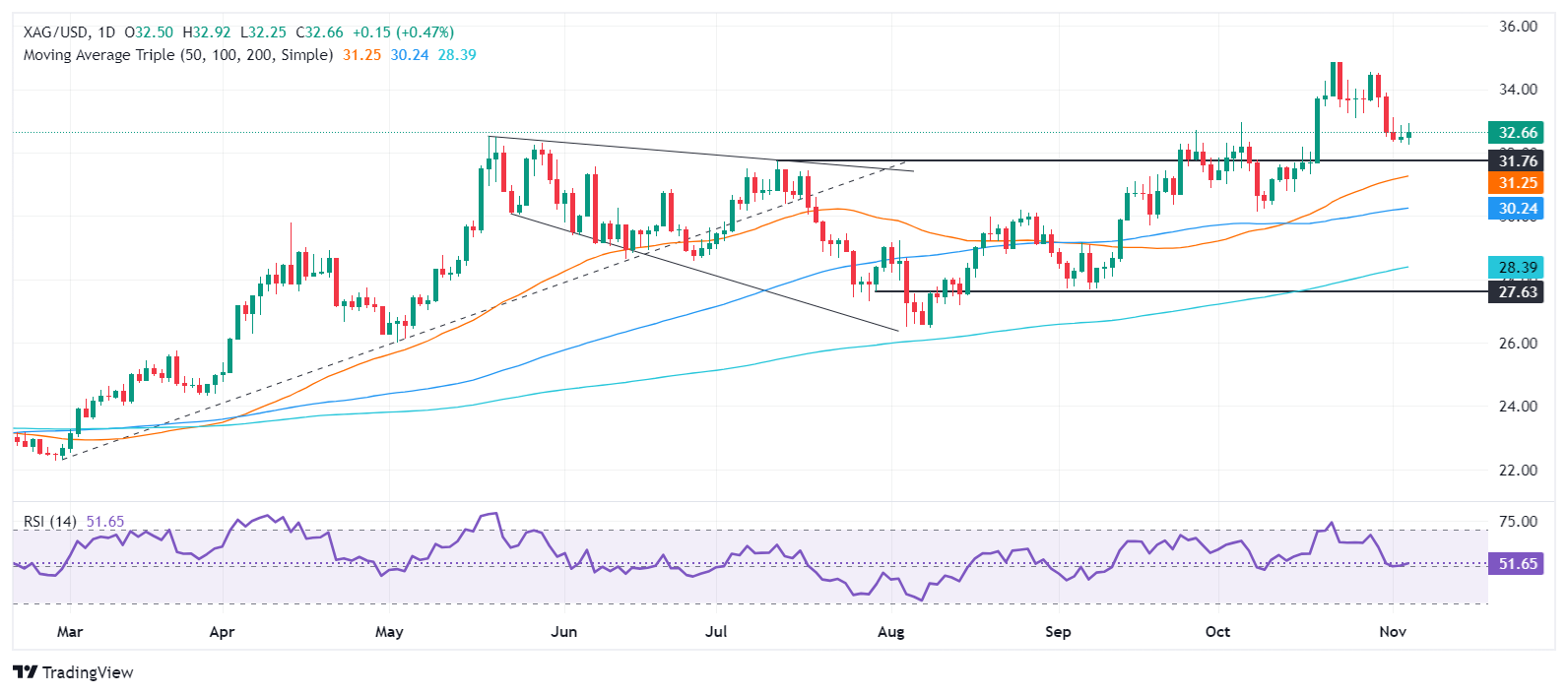Silver Price Forecast: XAG/USD edges higher above $32.50
- Silver's uptrend persists; a break above $33.00 may target October 31 high of $33.89.
- Failure to surpass $33.00 could see support tested at $32.25, with further downside toward $31.32.
- Market volatility expected as US election results unfold, influencing precious metals' performance.
Silver fluctuated around $32.50 during Tuesday’s session amid an expected volatile session, with investors awaiting US election results later. Greenback continues to lose ground against precious metals, with XAG/USD gaining over 0.60%.
XAG/USD Price Forecast: Technical outlook
Silver’s uptrend remains intact, but the precious metal remains below $33.00. This could keep sellers hopeful of driving price action lower, but momentum still favors buyers.
If XAG/USD clears the $33.00 mark, the next stop would be the high of the October 31 bearish candle at $33.89. Up next is the $34.00 figure, which, if cleared, bulls can re-test the year-to-date (YTD) peak at $34.86.
For a bearish resumption, sellers need to clear the $32.25 November 5 swing low. A breach of the latter will expose the October 17 doji’s daily low of $31.32, ahead of testing the 50-day Simple Moving Average (SMA) at $31.23.
XAG/USD Price Chart – Daily

Silver FAQs
Silver is a precious metal highly traded among investors. It has been historically used as a store of value and a medium of exchange. Although less popular than Gold, traders may turn to Silver to diversify their investment portfolio, for its intrinsic value or as a potential hedge during high-inflation periods. Investors can buy physical Silver, in coins or in bars, or trade it through vehicles such as Exchange Traded Funds, which track its price on international markets.
Silver prices can move due to a wide range of factors. Geopolitical instability or fears of a deep recession can make Silver price escalate due to its safe-haven status, although to a lesser extent than Gold's. As a yieldless asset, Silver tends to rise with lower interest rates. Its moves also depend on how the US Dollar (USD) behaves as the asset is priced in dollars (XAG/USD). A strong Dollar tends to keep the price of Silver at bay, whereas a weaker Dollar is likely to propel prices up. Other factors such as investment demand, mining supply – Silver is much more abundant than Gold – and recycling rates can also affect prices.
Silver is widely used in industry, particularly in sectors such as electronics or solar energy, as it has one of the highest electric conductivity of all metals – more than Copper and Gold. A surge in demand can increase prices, while a decline tends to lower them. Dynamics in the US, Chinese and Indian economies can also contribute to price swings: for the US and particularly China, their big industrial sectors use Silver in various processes; in India, consumers’ demand for the precious metal for jewellery also plays a key role in setting prices.
Silver prices tend to follow Gold's moves. When Gold prices rise, Silver typically follows suit, as their status as safe-haven assets is similar. The Gold/Silver ratio, which shows the number of ounces of Silver needed to equal the value of one ounce of Gold, may help to determine the relative valuation between both metals. Some investors may consider a high ratio as an indicator that Silver is undervalued, or Gold is overvalued. On the contrary, a low ratio might suggest that Gold is undervalued relative to Silver.